Plastic Analyzer
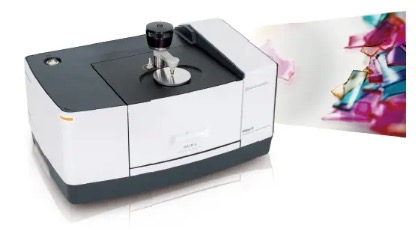
The Plastic Analyzer method package includes an FTIR spectral library for plastics degraded by UV rays and heat. Utilizing searches of this library demonstrates its effectiveness in the analysis of unknown samples that are difficult to identify with standard libraries. Examples include plastics degraded by exposure to UV rays as well as contaminants and defective items altered by heating.
What is Required for Plastic Analysis?
When analyzing plastics, libraries are used to qualify their material properties. However, infrared spectra of plastics that have been denatured (have deteriorated) due to heat or UV rays differ in shape from standard spectra, and qualifying them can sometimes be difficult.
To address this, the Plastic Analyzer includes a deterioration library, so highly accurate qualification can be performed reflecting the state of deterioration.
Plastic Analyzer Method Package
UV-Damaged Plastics Library
This library includes more than 300 spectra from the UV degradation of 14 types of plastic. This proprietary Shimadzu library includes the IR spectra for plastics degraded by UV rays for the equivalent of approximately 10 years using a super accelerated weathering chamber from Iwasaki Electric Co., Ltd.
Thermal-Damaged Plastics Library
This library includes more than 100 spectra from the degradation of 13 types of plastic heated to between 200 and 400 °C. This proprietary Shimadzu library contains IR spectra for plastics degraded by heating, acquired through measurements at the Hamamatsu Technical Support Center at the Industrial Research Institute of Shizuoka Prefecture.
Macro Program and Parameters
The system includes plastic measurement parameters and IR Pilot, a special program for IRSpirit that simplifies spectral measurements and the creation of reports, enabling analysts to perform everything from the measurement of target samples to data analysis easily. Even users unfamiliar with FTIR analysis can start work immediately.
Applications
Contaminant Analysis (Contaminants in Processed Items)
The measurement of a light brown semi-transparent contaminant on a plated item was performed. The figure below shows that the spectral pattern of the acquired infrared spectrum differs from the standard polyethylene (PE).
Plastic Analyzer shows the best match is heated PE. The Thermal-Damaged Library makes it useful for surmising the thermal history of the plastic.
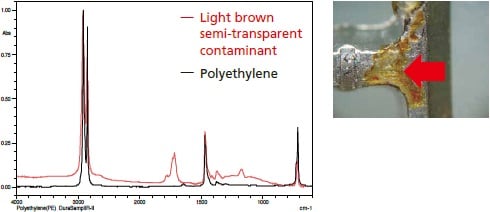
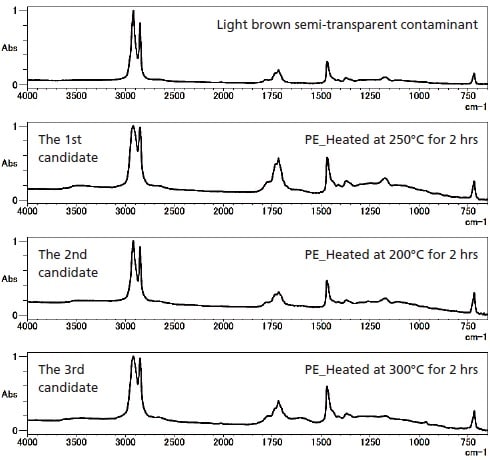
Evaluation of Deteriorated Samples
Plastics degrade as they experience molecular cleavage and cross-linking due to heat and light. As a result, in fault analysis and failure analysis, the qualities of deteriorated samples must be analyzed.
The figure at bottom left shows the infrared spectrum of a polypropylene (PP) sample that has been irradiated with UV rays. The UV irradiation has caused the plastic to deteriorate, and it is evident that the shape of the infrared spectrum has changed. The figures at bottom right show the search results from measurements by Plastic Analyzer of a white plastic (PP material) that was left outdoors for an extended period and exposed to UV rays. The infrared spectrum of the sample exposed to UV rays differs from the standard spectrum. Accordingly, in general library searches, different plastics such as polybutene are at the top of the results. In contrast, with Plastic Analyzer, PP denatured by UV rays is the top result.
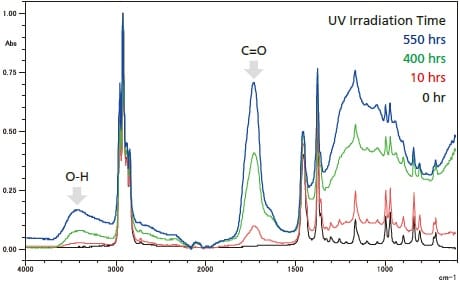
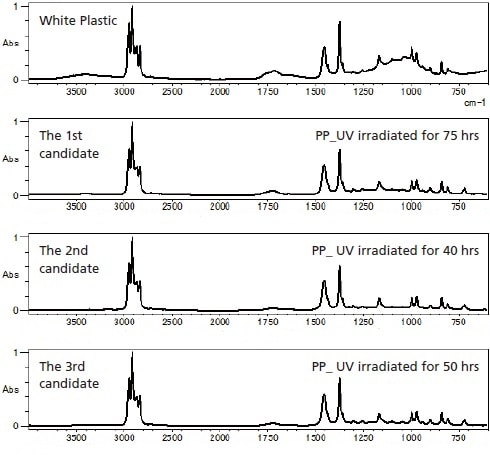
Target Sample Size and Search Method
| Item | Specifications |
|---|---|
| Sample Size | Plastic approximately 0.3 mm or larger There is no function to measure the size or quantity of the plastic. An infrared microscope is effective for analyzing plastic samples less than 0.3 mm in size. |
| Search Method | Search matching using a special library There is no function to determine the degree of deterioration. This library contains infrared spectra differing with respect to the UV irradiation time, heating time, and heating temperature. However, the irradiation and heating conditions noted in the data matches from library searches of the analyzed samples measured are at best reference values. Be aware that they do not indicate that the sample was placed under identical conditions. |
